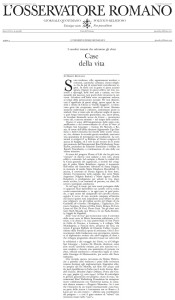We are referring to residences, villas, modest departments, or canonical convents, seminaries and religious institutes that for more than seventy years have kept secrets. In many cases, unconsciously ignored by people. However, in these buildings, in their attics and closets, basements and classrooms, in their most hidden labyrinths, many Jews found salvation.
It happened in Italy under German occupation, during the racial persecution.
We must not forget the importance of these shelters, often opened by men and women of the Church to their “older brothers”, because they are gestures that recover pieces of stories, releasing individual and collective memory, and transforming the stone into a symbol.
It is not just a matter of placing plaques in this or that place, or of renewing gratitude, but first of all of remembering the flames ignited by the Righteous – recognized as such, or anonymous – in the moment of darkness.
This is the reason of the inauguration of the commemorative plaque and the recognition as “House of Life” to the College of St. Joseph – Institute of Merode in Rome, in honor of the then director Segismundo Ugo Barbano and the Community of Brothers of the Christian Schools, who during the Second World War hid about 40 persecuted by the fascists.
The ceremony will take place on Tuesday 14 February at the Plaza España Convention Center, and is just one of the many that have already been promoted by the Raoul Wallenberg International Foundation (IRWF), chaired by Eduardo Eurnekian and founded by Baruch Tenenbaum, continuing its latest initiatives.
The “Houses of Life” project of the IRWF has already “honored” Italian cities and not just some buildings and communities. For example, in Rome, the building of the General Curia of the Capuchins, in memory of the courage of Father Maria Benedetto; the monastery of the Order of the Most Holy Savior of St. Bridget, in memory of Mother Mary Elizabeth Hesselblad. Also, the convent of Our Lady of Sion, where, during the occupation of the capital, two nuns Maria Agustina (Virginia Badetti) and Maria Ines (Emilia Benedetti) saved the lives of a hundred people, including Jews, Partisan deserters and antifascists. There, in 1943, the sisters hung a sign outside the building that said “extraterritorial zone”. At the moment the bell was knocked on the front door, the inside bell rang, and in a second they made everyone disappear (a very common in other religious houses).
Among the Italians who found refuge on the Via Garibaldi 28 were Modigliani, Tagliacozzo, Ferruccio Sonnino, Emma and Elisa Alatri, Renata Di Cori, Leone and Elio Di Cori and Peter Gaya. Among the foreign Jews was Ruth Musafia (later Weiss) and her uncle Konforty Sasha, who escaped from Zagreb.
Other “Houses of Life” that have already been recognized are: the convent of the Sisters of Our Lady of Sorrows in Florence; The church and the parish house of San Pedro de Cellis de Terzone, in Leonessa; The Villa Mondragone College, in Frascati, whose rector was the Jesuit Raffaele Ghantuz Cubbe, vice president of the Pontifical Society for assistance.
The recognition of the non-governmental foundation that bears the name of the Swedish diplomat who saved thousands of Jews and develops educational programs based on the values of solidarity and courage of the Righteous, will distinguish the university of St. Giuseppe – Instituto De Merode, as well as other Catholic schools, for having sheltered among his students and professors about forty people, including Jews, antifascists and officials linked to Colonel Giuseppe di Montezemolo, who was later assassinated in the Ardeatina Fossils. This story was narrated and published by Dennis Walters, who fifteen years ago translated the plans of the Roman resistance for the Anglo-Americans, posing as a student of Merode, in the book reprinted in Italy with different titles «Benedetti Italiano, Benedetti English “(Milan, Ponte alle Grazie, 1991, 175 pages, € 24.90).
In order to involve younger generations in the “Houses of Life” project, the Raoul Wallenberg International Foundation has forged new partnerships with the Lumsa University, the Roman Jewish community and the “Memory Project”.
Although the initiative tends to be international, “a good part of the research now focuses on Rome and Lazio for a single reason“- says a project coordinator – “which is the large number of saved people who found refuge in those “houses”.
Translation: IRWF

